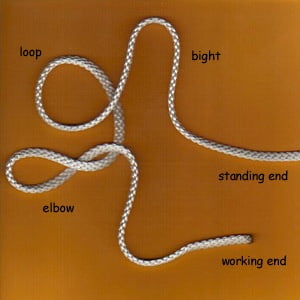These are commonly used terms relating to knots and their components.
Bend: Joining of two ropes or two ends of a rope together.
Bight: Made by folding a piece of rope so that the two parts lie alongside each other. Used to finish may knots, making them easy to untie simply by pulling on the tail. A Bight often resembles a Loop but does not mean the same.
Binding Knot: Knot that either constricts a single object or holds to objects snugly together.
Capsizing: A knot that has deformed or capsized into a different structure, usually due to improper tying or misuse.
Decorative Knot: Aesthetically pleasing knot derived from other well-known knots. Often used in folk art.
Dressing a Knot: Arranging the components of the knot to optimize security and strength.
Elbow: Any two nearby crossings of rope, created when and additional twist is made in a loop.
Flake: Any number of turns in a coiled rope.
Frapping Turns: Additional turns added in another axis to bind or tighten a Lashing.
Friction Hitch: A knot that attaches one rope to another in a way that allows the knot’s position to easily be adjusted. Also referred to as slide-and-grip knots.
Hitch: Attaches a rope to something.
Jamming: A knot that becomes difficult to untie after use.
Lashing: An arrangement of rope used to secure two or more objects together in a rigid manner.
Loop: Made when a rope forms a partial circle by passing the working end of a rope over itself.
Loop Knot: Knot that forms a fixed loop.
Noose: Any sliding loop in which the loop tightens when pulled.
Open Loop: A curve in a rope that resembles a semi-circle in which the legs are not touching or crossed.
Racking Turn: Lashing turns which pass between poles to bind against the other pole.
Round Turn: Two passes of a rope around an object, completely encircling it.
Seizing: A knot that binds two pieces of rope together side by side, normally to create a loop.
Setting: The process of tightening a knot.
Slipped knot: Any knot that unties when and end is pulled.
Splice: A knot made by weaving the strands of the ends of two ropes together. Maintains the strength of the rope and intended to be permanent.
Standing End: The long end of the rope – the part not active in knot tying. The part opposite the working end.
Stopper knot: A knot in the end of the rope – used to prevent the end of a rope from passing through a hole.
Tail: The shorter end of the rope left over after the knot is formed.
Turn: One pass of the rope round or through an object.
Whipping: A binding used to prevent a rope’s end from untying or fraying.
Working End: The part of the rope active during knot tying. The part opposite the standing end.
